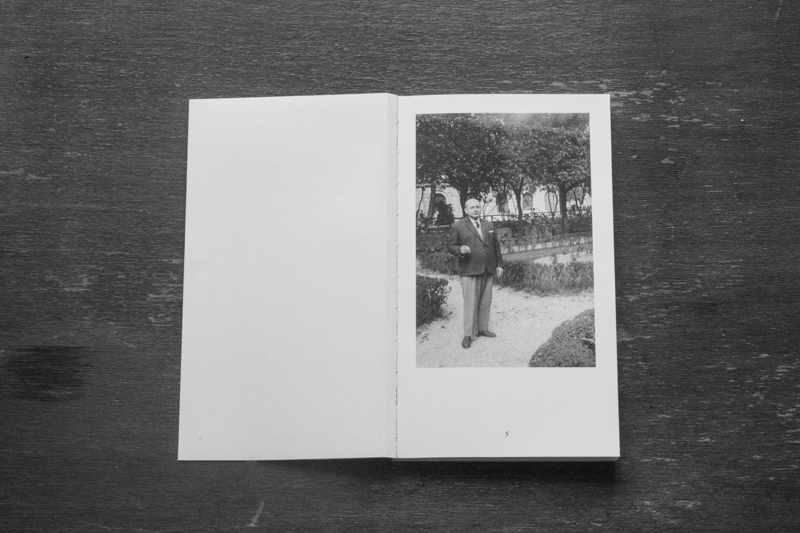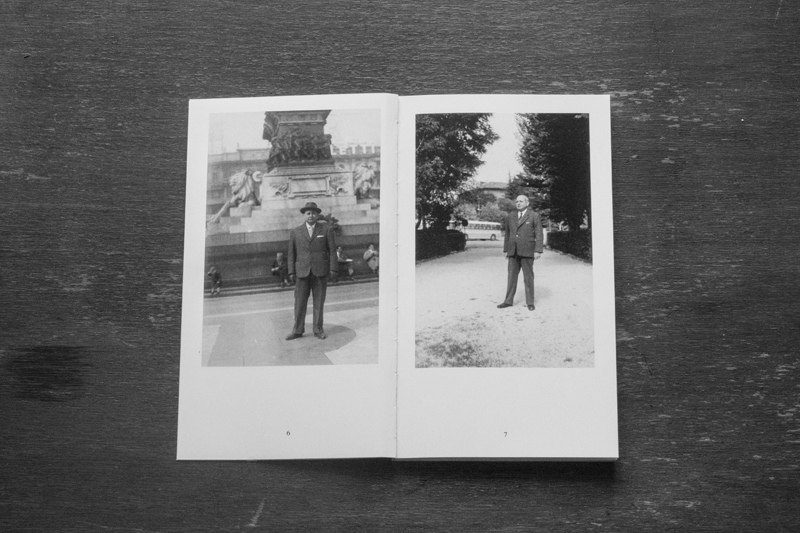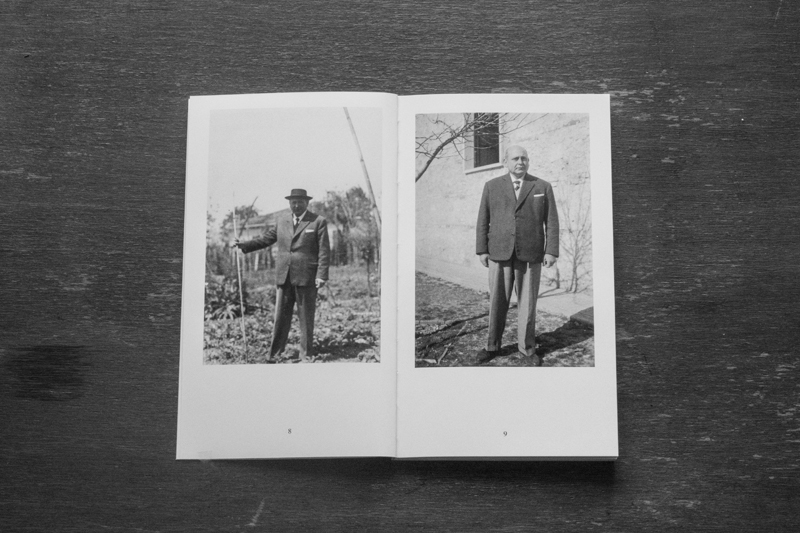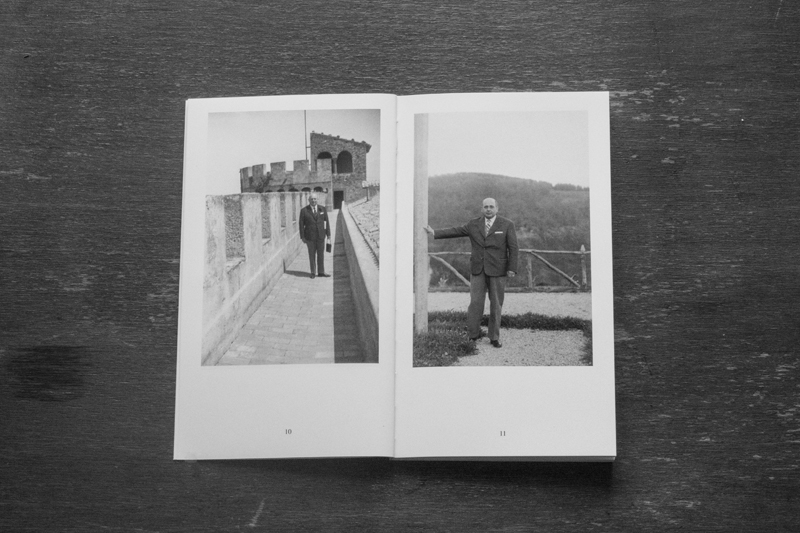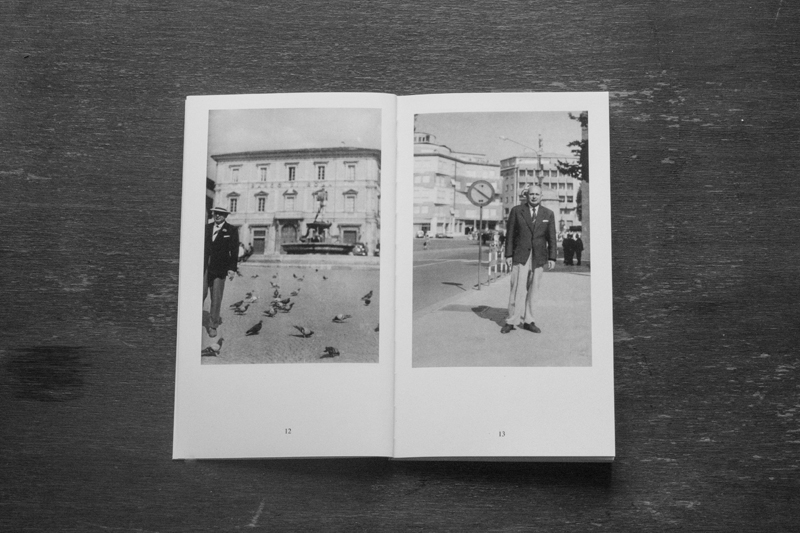Massimiliano Tommaso Rezza, artist
Un certo Salvatore M., published by Pneumatica, 2019

Massimiliano Tommaso Rezza objects of research are visual language in photography and social photographic practice.
The book Un certo Salvatore M. presents a collection of portraits of an Italian State employee. Over the years and many times a year, Salvatore M. asked his wife to take his portrait, and, as it appears, the purpose of this portraiture is to allow the man to fit and to identify with his social persona, his bearings. In almost all of his portraits he looks like a monolithic character. As a role model, impersonal and still, he looks emotionless, exactly as the social culture had imposed on the male at his time. This consistence, however, is broken when we encounter two photos in which his wife is photographed with him. Here his posture and his facial expressions change. He is no longer the solid, impassible man; on the contrary, he is awkward and clumsy. This latter behavior is in obvious contrast, and is contradictory, with the other portraits to the point that we finally sense the pure construction and visual fiction of the whole operation of being photographed and creating a collection of portraits. The reading of the physiognomic expression of the main character was therefore a pivotal moment in revealing the level of truthfulness (or masquerade) and the narrative intention of the whole collection of photos. This said, however, it is also important to deal with the reliability and objectivity of the signs in the photograph we can read and interpret. We have, therefore, to pay attention to the neutrality of the photographic signs and the level of interference, formal and aesthetic, of the photographer. When we deal with photographic documents we cannot neglect the author/operator’s agency, his true intentions, the intervention of his visual culture in his photos which may transform objective information into representation, translating realistic data into further expression.
The reading of physiognomy, posture and emotions in photography. The case of the portraits of Salvatore M.
Aby Warbug applied the study of physiognomy and postures to his work Die Typen der Brancacci-Capelle influenced by the research done by Theodor Piderit (Mimik und Physiognomik) and August Scharsow (about expressive psychology ). As postulated by Didi-Huberman in his book L’image suivante. Histoire de l’art et temps des fantôme selon Aby Warbug, Aby Warburg also relied on Charles Darwin’s theories which see a strict correspondence between expressions, physiognomy and internal states of being. Darwin discovered that direct observation of expressions allows one to see the connection those expressions have with involuntary responses and emotions. Physiognomy reveals clearly that certain emotions, behavioral responses and manifestations of thoughts are directly associated with expression and pathos. In addition, archaic and primitive responses to stimuli appear to resurface on man’s face and postures. This means that the body also preserves collective memory of gestures that trace back to immemorable times. Physiognomy offers then two type of information: socio-historical and emotional/personal. Both types of information coexist and can be detected in the visual document. This perceptual method is also used by ethnologists and anthropologists when studying human expressions and postures as symptoms that may be connected to social practice and therefore collective memory. The Italian anthropologist Franco La Cecla, in his book Saperci Fare (“Savoir faire”) deals with, amongst other things, the postures and expressions of southern Italian men when hanging out together in public spaces. La Cecla refers to postures and expressions as objective signs embodied by men and related to the cultural tradition going back to archaic eras, exactly as Aby Warburg thought and operated through physiognomic and postural signs. According to La Cecla the presence and the posture of a body is a “crystallization of an absolute social pattern, of an anthropological habitus in which a particular culture is so imbued to transform it into ‘body technique’, ‘mastery’, savoir fair and nonchalance.” Postures and physiognomic expressions, therefore, are signs through which time, culture, habits and thoughts are revealed and become ostensive. To a certain extent I relied on these conceptual inputs when I was working on the book I published for my Pneumatica project.
Could you identify some constants in your work?
The variability of the meaning and use of photography in different contexts, media, fields.
How did you find out about Aby Warburg’s work? What interests you the most?
I first encountered the ideas of Aby Warburg while I was reading an essay about Walter Benjamin. I was struck by Warburg’s idea that thoughts can be communicated by signs and these signs can undergo a transformation to find a better translation of an idea for the current times. That means that images are temporary containers that change shape and expression. Their transformation is a process that reveals, as a symptom, an urgent cultural and historical aspect of the collective psyche. Images are both symptoms and living beings.
How would you define an Atlas?
I think in general an atlas is a display of tables/images which present and illustrate an idea. An atlas is an illustrated collection of certain aspects of knowledge based on similarities or oppositions of some types. I also admire Atlas by Gerhard Richter, because the use of pictures here is for purposes that defy any idea of organization, direction or suggestion about how to collect pieces of information coming from the real world.
Do you know about the existence of Mnemotechnics?
Yes.
Which mnemonic system guides the organization of your material?
I like the nature of reality and the way it presents itself, in its chaotic apparition. I think that the essence of reality lies exactly in its necessary occurrence and its spontaneity. It is banal, but that is what catches my attention. The information from reality is always richer than our thoughts about it, and any attempt to find a strict correspondence between events is but an applied ideology which may force the natural aspect and the hidden sense of things. I tend to use different ways of organizing this chaotic material: one is association between similar images, while the other is contraposition, but more often it is the chronology of the appearance of the events. This chronological appearing of the events is itself meaningful, actually it is “the meaning” because it offers objects as they surface towards us, as they become present to us. Very often I use photographic sequences for this reason.
Are there visual and emotional formulas (pathosformeln) in your project?
Yes, sometimes I do rely on historical forms and their variations around a specific theme or expression especially when I want to underline the aesthetic nature of some forms, when I want to focus on the artificial additions of aesthetic language to reality and how these additions are connected to known patterns. It is somehow like using a sort of a citation within an image.
In your work, do you identify formal or conceptual recurrences such as repetitions and disruption, distance and proximity, identity and migration, conflict and colonization?
It really depends on what I am working on. All of these aspects attract me. In my work Die andere Seite, I think I paid attention especially to recurrences and repetitions, and therefore sequences which are the most basic pattern that show how single signs can naturally change and vary just in a short period of time.
In your work, what is the balance between image and text?
Sometimes text leads the photographs and actually transforms their fruition (which I do not like), while other times the text can be the counterpart that opposes the photos or allows pictures to remain open to different points of view.
Thinking about Warburg’s ‘good neighborhood rule’, what are the books that underpin your project?
- Mr. Hire by Georges Simenon
- One and Three Chairs by Joseph Kosuth, which is not a book.
- The practice of everyday life by Michel de Certeau
- The poems of Sergio Corazzini or Guido Gozzano
- Saperci Fare by Franco La Cecla
Are there more topics of interest that we haven’t pinned down?
The possibility that free association and/or opposition amongst images can be totally subjective and deliberate. There is a serious risk that subjective free association can depreciate a body of work if it is not lead by strict methodology applied to the visual symptoms/signs.
Massimiliano Tommaso Rezza (born 1967) is an artist and independent researcher in photography and video. His artistic research revolves around the relation between language (aesthetics, conventions, stereotypes and ideological influence) and photographic practice (authorship, amateurism, commercial and communicative field). In 2019 he started the publishing project Pneumatica through which he thematically focuses on practical and theoretical aspects of photography. He teaches Photography for the Media at Richmond University in Rome.
